Birth of Montgomery Bus Boycott, Council Hall Alabama State University
Introduction
Text-to-speech Audio
Built by Bear Lumber Company of Montgomery, Councill Hall is a three-story brick building that housed classrooms, laboratories, and administrative offices for Alabama State University (ASU). The building was named in honor of William Hooper Councill, a formerly enslaved man who became the first president of Alabama A&M University. After the arrest of Rosa Parks’ arrest on December 1, 1955 for violating segregated seating on Montgomery buses, English professor Jo Ann Robinson used the basement of this building to create flyers calling for African American residents to not ride city buses on Monday, December 5. Robinson along with members of the Women’s Political Council and two students mimeographed copies of the flyer in the basement and distributed the material throughout the city. The group was effective in spreading the word and on the day of the boycott, ninety percent of the city's African American bus riders participated. Recognizing their potential to cripple the city bus system by withholding their patronage, a mass meeting of African American leaders and residents decided to continue the boycott.The one-day protest became a thirteen-month boycott, which ended segregated seating on city buses.
Images
This historical marker was erected in 2015 and emphasizes the role of Jo Ann Robinson in planning the boycott.
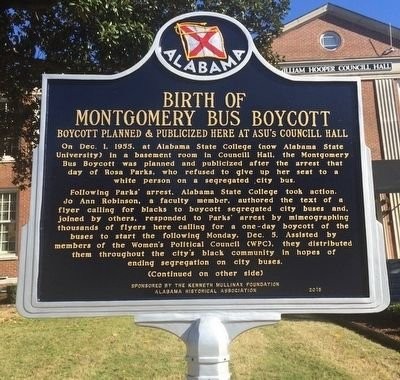
Councill Hall, circa 2009
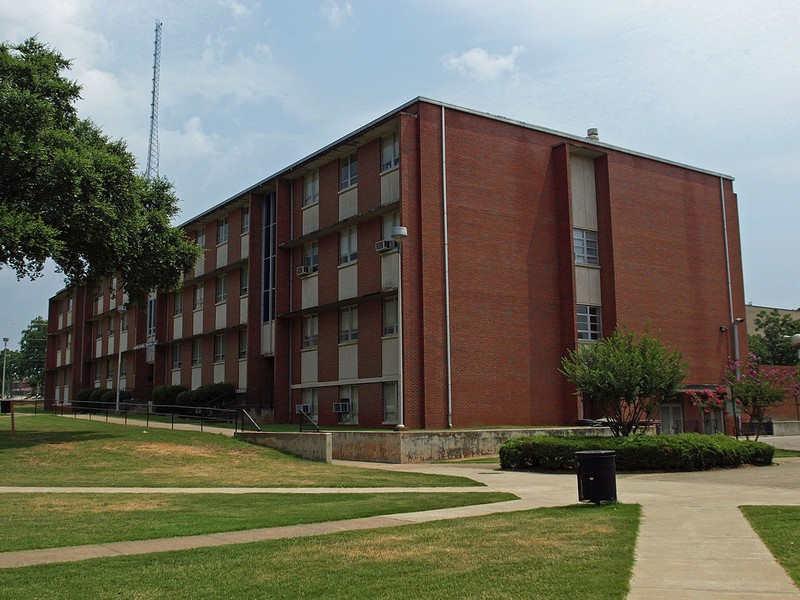
Jo Ann Robinson, “Local Activists Call for a Bus Boycott in Montgomery.”
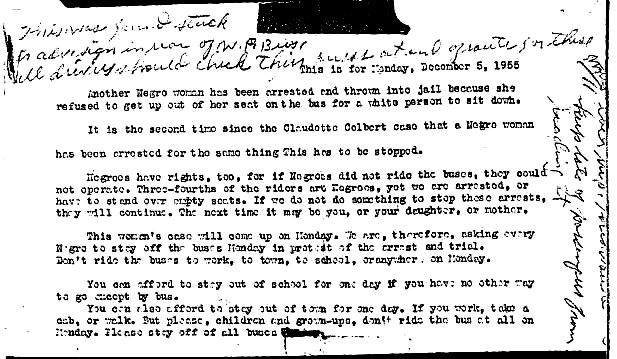
Notice to the Montgomery Public from the Negro citizens of Montgomery explaining their reasons for the Montgomery bus boycott.
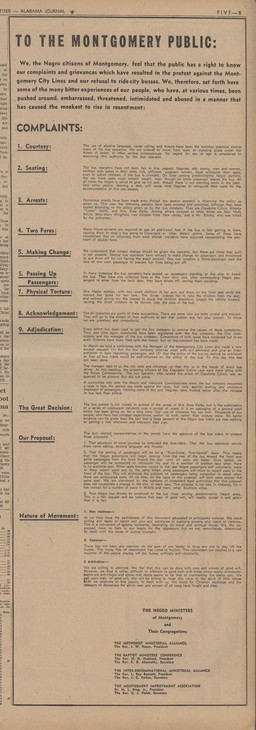
Jo Ann Robinson, president of the Women's Political Council during the Montgomery bus boycott
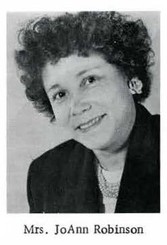
This photo was taken after Rosa Parks was arrested and taken to jail, where she was fingerprinted.
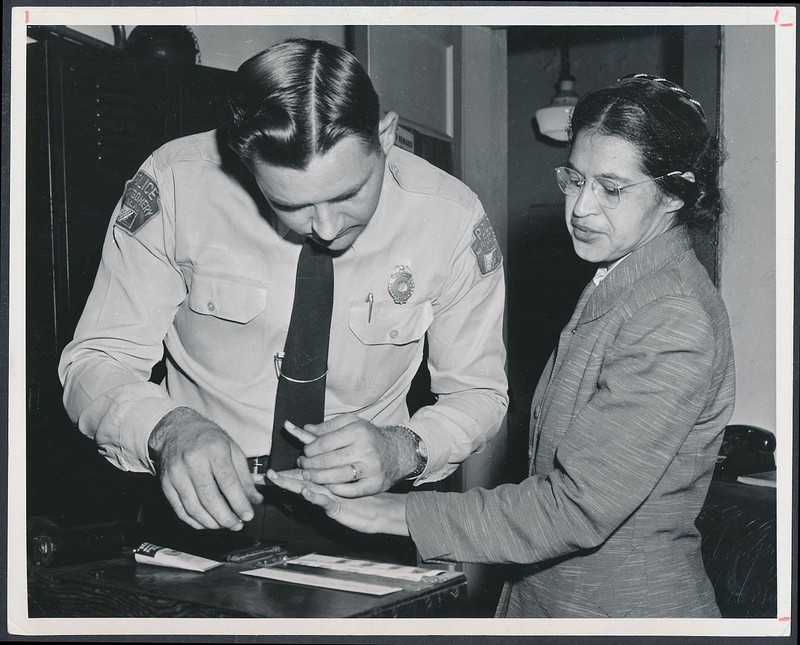

Backstory and Context
Author-Uploaded Audio
00:00 / 00:00
Dr. Valda Montgomery, daughter of Dr. Richard Harris Jr., talks about Jo Ann Robinson and how her mother, Vera Harris, helped with the boycott flyers.
Text-to-speech Audio
On December 1, 1955, Montgomery, Rosa Parks boarded a city bus in Montgomery, Alabama, not knowing that this trip would become one of the most significant moments of modern American history. When a white man boarded the bus, the bus driver told all the Black passengers to move to the back. Rosa Parks refused to leave her seat and city police soon arrived and arrested her for disorderly conduct. Parks’ arrest sparked the Montgomery Bus Boycott, a protest against the city ordinance that mandated segregated seating. Calls for a bus boycott began ten years before Parks refused to give up her seat.
Founded by Dr. Mary Fair Burks in 1946, the Women's Political Council (WPC) addressed civic issues within the Black community and confronted the racial injustice faced by the Black residents. Members of the WPC included professional women such as teachers and professors who lived in Centennial Hill, the general neighborhood around Alabama State University. The WPC had met with J.H. Bagley, manager of Montgomery City Lines, Inc., and city mayor, W.A. Gayle to demand better treatment for Black patrons with no success of a permanent change. For years, the WPC debated whether they should stage a protest against the buses after they received numerous reports of discrimination. Though others have challenged the segregation of city buses, the case of Rosa Parks pushed plans for a boycott forward.
On December 2, 1955, in the basement of Councill Hall, Jo Ann Robinson and the WPC drafted a message calling for Black residents to not ride the bus on Monday, December 5. Several members of the WPC and two ASU students turned their fingers purple mimeographing the notices. Early the next morning, they began distributing these leaflets all around Montgomery. On the day of the protest, Robinson and other civic leaders waited anxiously as empty buses rode past their homes. The protest had worked. Roughly 90% of the African American residents in Montgomery decided to not ride the bus that day. At a mass meeting later that day, the protestors decided to extend the boycott. The infamous Montgomery bus boycott lasted from December 5, 1955, to December 20, 1956. The boycott resulted in a U.S. Supreme Court, Browder v. Gayle, which ended bus segregation laws.
Several prominent civil rights leaders emerged from the boycott, most notably Martin Luther King Jr. and the establishment of the Southern Christian Leadership Conference in January 1957.
Cite This Entry
Layne, Melanie et. al. "Birth of Montgomery Bus Boycott, Council Hall Alabama State University." Clio: Your Guide to History. April 20, 2022. Accessed April 1, 2025. https://theclio.com/tour/2180/1
Sources
"Civil Rights Movement." Accessed September 18, 2017. http://www.history.com/topics/Black-history/civil-rights-movement.
"Montgomery Bus Boycott (1955-1956)." The King Center. Accessed September 18,
2017. http://kingencyclopedia.stanford.edu/encyclopedia/encyclopedia/enc_montgomery_bus_boycott_1955_1956.
Jo Ann Robinson and David J. Garrow. The Montgomery Bus Boycott and the Women Who Started It: The Memoir of Jo Ann Gibson Robinson (Knoxville: University of Tennessee Press, 1987).
"William Hooper Councill Hall," Alabama State University Library Archives Department, Alabama State University, https://cdm17283.contentdm.oclc.org/digital/collection/buildings/id/592.
Courtsey of Chis Pruit, Wikimedia Commons
Courtesy o fGeorge Mason University Center for History and New Media and Stanford University School of Education, "Rosa Parks," Historical Thinking Matters.
Alabama Department of Archives and History.
1959 Alabama State University Yearbook
Photo: Public Domain, via Wikipedia Commons https://en.wikipedia.org/wiki/Montgomery_bus_boycott#/media/File:Rosa_Parks_being_fingerprinted_by_D...

